Business owners must have several meetings lately on data management, and especially integration, where the ability to explore alternatives has been critical. A smart data integration strategy can bring your business a competitive advantage and overall increased customer satisfaction. This will result in reliable, high quality, and real-time data. In business intelligence, data integration plays a vital role in making effective business decisions.
Data Integration collects raw material (data from various sources) and combines it to create a new product (a data warehouse-DW). A DW contains relational structures that do not exist elsewhere in a general database. For BI, data going into a data warehouse must be repurposed to create aggregated, calculated, and time-series data, assembled into multidimensional data models. DI doesn’t just collect data; it transforms the data into these required structures.
What is Data Integration?
It may sound slightly technical but the concept is really simple. In fact, data integration is one of the most important IT concepts for any business and it isn’t new. Data integration is nothing but combining information from various sources into something useful (meaningful) data. It’s about efficiently managing data and making it available to those who need it. Both technically and as a business process, we define it as “discovery, cleansing, monitoring, transforming and delivery of data from a variety of sources.”
Availability-Accessibility
Asset data that is easily retrieved, viewed, queried, and analyzed by anyone within the organization. The integration of such data into every area of an organization that can benefit from its support in innovation and right decision-making.
Timeliness
Well-organized data can be quickly inserted or updated, one input will often apply the data across a variety of linked systems, and the information can be time stamped to reflect its accuracy.
Accuracy and Integrity
Errors are greatly reduced because the integration environment drives higher quality of input and can include automatic or convenient error checking and verification alerts in the system.
Consistency and Clarity
Integration requires the clear and unique definition of various types of data, data integration avoiding confusion or conflict data in input files.
Completeness
All available information, including both historical and recent data, is accessible in an integrated data warehouse, with any missing records or fields identified and flagged via the integration process.
Decreased Duplication
Identical data is eliminated reducing the need for numerous updates and ensuring everybody is working on the exact same information.
Faster Processing and Turnaround Time
Less time is spent on consolidating and transmitting data into data warehouse of the system. The unified data environment saves time by eliminating consolidation and distribution to distinct users and allows many users to conduct separate analyses concurrently.
Lower Data Acquisition and Storage Cost
Data is collected or processed only once, and the information is consolidated and stored at locations supporting optimal convenience and ease of maintenance.
Greater Accountability
Data integration allows rapid and more accurate data visualization, data reporting and accomplishments, including full attribution of results to relevant agency units and functions.
How does Data Integration work in Your Business?
Basically, all the information you have stored in the many different software systems that your company uses and merges together into one. With data integration, all the information is kept online in one Data Warehouse platform that is easy for anyone in your company to use.
Easily accessible data means easily transformed data. People will be more likely to integrate the data into their ideas, share the results, and keep the data up to date. This cycle of available data is key for innovation and knowledge-sharing for your business.
Integrated data means transparent processes within your company. Implementing location intelligence to your dataset, for instance, makes it spatially extensive and offers new levels of insight around that dataset, which leads to better decision-making.
Integrating with other input data types can also mean conforming standards to save on business costs. Further, open source data formats offer many advantages for businesses growth.
If you’re already doing it, then you’re ahead of the curve. If you’re not, then your first step is to ensure integrate data easily with your current and future business systems. That way you can truly maximize the ROI.
Why is Data Integration Important for Business Success?
Data integration provides a way to close deals quicker, increase revenue, and create deep-rooted accounts. Integration is crucial to data processes such as marketing automation, big data analytics, cloud integration, and business intelligence.
• Complete clients data adds value to any client-oriented business process, from sales and marketing to customer service.
• Complete product data adds value to business processes for procurement, supply chain, manufacturing, and product management.
• Complete asset data adds value to the management of assets, facilities, inventories, fleets, and office equipment.
• Complete employee data adds value to HR system, shift scheduling, payroll, OFAC compliance, and benefits management.
Thus, Data Integration increases transparency, reframes the data to provide accurate business insights & helps for making right business decisions.



